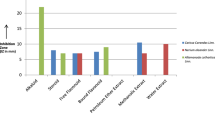Abstract
Microbial resistance is a major drawback in chemotherapy of microbial or fungal infection disease. In this study, the antifungal activity of ethanol extract of a selected plant (Sarcococca saligna) has been investigated against clinical isolates of Aspergillus niger, Aspergillus treus, Aspergillus flavus, and Aspergillus fumigatus. Also, the enhancement of the antifungal activity of fluconazole by this extract was further evaluated against mentioned test strains. Conventional disk diffusion method was used to assay the antifungal activity of S. saligna ethanol extract in the absence and presence of fluconazole. The highest antifungal activity was observed against A. treus. The ethanol extract of S. saligna enhanced the antifungal activity of fluconazole against A. niger and A. treus and A. flavus. At the highest tested contents (4 mg/disk), 1.15-, 0.64-, and 2.47-fold increases in inhibition zone surface area were observed for A. niger, A. treus, and A. flavus, respectively. However, no enhancing effect was observed for this plant extract against Aspergillus fumigates at tested contents (0.5, 1, 2, 3, and 4 mg/disk). In a separate experiment, the general cytotoxicity of the ethanol extract of S. saligna was examined with brine shrimp assay. This plant extract showed low cytotoxicity against Artemia salina (LC50 = 186 µg/ml).
Similar content being viewed by others
References
Sharma, R., Sharma, C. L., & Kapoorl, B. (2005). Antibacterial resistance: current problems and possible solutions. Indian Journal of Medical Sciences, 59(3), 120–129.
Wright, G. D. (2005). Bacterial resistance to antibiotics: enzymatic degradation and modification. Advanced Drug Delivery Review, 57, 1451–1470.
Wright, G. D. (2000). Resisting resistance: new chemical strategies for battling superbugs. Chemical Biology, 7, R127–R132.
Renau, T. E., Hecker, S. J., & Lee, V. J. (1998). Antimicrobial potentiation approaches: targets and inhibitors. Annual Reports in Medical Chemistry, 33, 121–130.
Lak, P., Amini, M., Safavi, M., Shafiee, A., & Shahverdi, A. R. (2008). Enhancement of the antibacterial activity of ciprofloxacin against staphylococcus aureus by 3-alkyl esters and 3-aryl esters of hexahydroquinoline derivatives. Arzneimittelforschung, 58(9), 464–468.
Gibbons, S., Oluwatuyi, M., & Kaatz, G. W. (2003). A novel inhibitor of multidrug efflux pumps in Staphylococcus aureus. Journal of Antimicrobial Chemotherapy, 51, 13–17.
Shahverdi, A. R., Rafii, F., Fazeli, M. R., & Jamalifar, H. (2004). Enhancement of antimicrobial activity of furazolidone and nitrofurantoin against clinical isolates of Enterobacteriaceae by piperitone. International Journal of Aromatherapy, 14(2), 77–80.
Shahverdi, A. R., Fazeli, M. R., Rafii, F., Kakavand, M., Jamalifar, H., & Hamedi, J. (2003). Inhibition of nitrofurantoin reduction by menthol leads to enhanced antimicrobial activity. Journal of Chemotherapy, 15(5), 449–453.
Rafii, F., & Shahverdi, A. R. (2007). Comparison of essential oils from three plants for enhancement of antimicrobial activity of nitrofurantoin against enterobacteria. Chemotherapy, 53, 21–25.
Shahverdi, A. R., Rafii, F., Tavassoli, F., Bagheri, M., Attar, F., & Ghahraman, A. (2004). Piperitone from Mentha longifolia var. chorodictya Rech F. reduces the nitrofurantoin resistance of strains of enterobacteriaceae. Phytotherapy Research, 18, 911–914.
Shahverdi, A. R., Monsef-Esfahani, H. R., Tavasoli, F., Zaheri, A., & Mirjani, M. (2007). Transcinnamaldehyde from Cinnamomum zeylanicum bark essential oil reduces the clindamycin resistance of Clostridiumdifficile in vitro. Journal of Food Science, 72, 55–58.
Stavri, M., Piddock, L. J. V., & Gibbons, S. (2007). Bacterial efflux pump inhibitors from natural sources. Journal of Antimicrobial Chemotherapy, 59(6), 1247–1260.
Alimirzaee, P., Gohari, A. R., Hajiaghaee, R., Mirzaee, S., Jamalifar, H., Monsef-Esfahani, H. R., et al. (2009). 1-methyl malate from Berberis integerrima fruits enhances the antibacterial activity of ampicillin against Staphylococcus aureus. Phytotherpy Research, 23(6), 797–800.
Walsh, T. J., Anaissie, E. J., Denning, D. W., Herbrecht, R., Kontoyiannis, D. P., Marr, K. A., et al. (2008). Treatment of aspergillosis: clinical practice guidelines of the Infectious Diseases Society of America. Clinical Infectious Disease, 46(3), 327–360.
Pfaller, M. A., Diekema, D. J., & Rinaldi, M. G. (2005). Antifungal drugs: mechanisms of action, drug resistance, susceptibility testing, and assays of activity in biological fluids, 5th ed. In V. Lorian (Ed.), Antibiotics in laboratory medicine (pp. 226–266). Baltimore: Lippincott Williams & Wilkins.
Baker, S. E., & Bennett, W. (2007). An overview of the Genus Aspergillus, vol 26. In G. H. Goldman & S. A. Osmani (Eds.), The Aspergilli: Genomics, medical aspects, biotechnology, and research methods (pp. 3–15). New York: CRC.
Matin, A., Khan, M. A., Ashraf, M., & Qureshi, R. A. (2001). Traditional use of herbs, shrubs and trees of Shogran valley, Mansehra, Pakistan. Pakistan Journal of Biological Sciences, 4(9), 1101–1107.
Ghayur, M. N., & Gilani, A. H. (2006). Studies on cardio-suppressant, vasodilator and tracheal relaxant effects of Sarcococca saligna. Archives of Pharmacal Research, 29(11), 990–997.
Rahman, A., Feroz, A. F., Naeem, I., Haq, Z., Nawaz, S. A., Khan, N., et al. (2004). New pregnane-type steroidal alkaloids from Sarcococca saligna and their cholinesterase inhibitory activity. Steroids, 69(11–12), 735–741.
Giliani, A. U., GHayur, M. N., Khalid, A., Haq, Z., Choudhary, M. I., & Rahman, A. (2005). Presence of antispasmodic, antidiarrheal, antisecretory, calcium antagonist and acetylcholinesterase inhibitory steroidal alkaloids in Sarcococca saligna. Planta Medica, 71(2), 120–125.
Rahman, A., Anjum, S., Farooq, A., Khan, M. R., Parveen, Z., & Choudhary, M. I. (1998). Antibacterial steroidal alkaloids from Sarcococca saligna. Journal of Natural Product, 61(2), 202–206.
Edwin, J., Beer, D., & Sherwood, M. B. (1945). The paper-disc agar-plate method for the assay of antibiotic substances. Journal of Bacteriology, 50(4), 459–467.
Mongelli, E., Martino, V., Coussio, J., & Ciccia, G. (1996). Screening of Argentine medicinal plants using the Brine Shrimp Microwell Cytotoxicity assay. International Journal of Pharmacognosy, 34, 249–254.
Acknowledgments
The biological experiments were supported by Medicinal Plants Research Center, Faculty of Pharmacy, Tehran University of Medical Sciences (Tehran, Iran). Also, collection of plant and extraction procedures was supported by University of Peshawar and the Higher Education Commission, Pakistan, under its indigenous Ph.D. scheme.
Author information
Authors and Affiliations
Corresponding authors
Rights and permissions
About this article
Cite this article
Mollazadeh Moghaddam, K., Arfan, M., Rafique, J. et al. The Antifungal Activity of Sarcococca saligna Ethanol Extract and its Combination Effect with Fluconazole against Different Resistant Aspergillus Species. Appl Biochem Biotechnol 162, 127–133 (2010). https://doi.org/10.1007/s12010-009-8737-2
Received:
Accepted:
Published:
Issue Date:
DOI: https://doi.org/10.1007/s12010-009-8737-2




